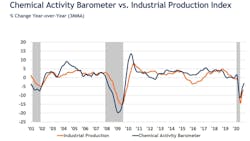The Chemical Activity Barometer (CAB), a leading economic indicator created by the American Chemistry Council (ACC), rose 0.9% in October on a three-month moving average (3MMA) basis, a marked deceleration from the 1.5% gain in September and 2.6% gain in August.
On a year-over-year basis, the barometer was down 3.3% in October, ACC said.
The unadjusted data show a 0.1% gain in October following a 0.8% gain in September and a 1.9% gain in August. The diffusion index eased from 65% to 59% in October. The diffusion index marks the number of positive contributors relative to the total number of indicators monitored. The CAB reading for September was revised downward by 0.26 points and the reading for August was revised downward by 0.30 points. These were volatile months for the data.
“With six consecutive months of gains, the October CAB reading remains consistent with recovery in the U.S. economy,” said Kevin Swift, chief economist at ACC.
The CAB has four main components, each consisting of a variety of indicators: Production, equity prices, product prices, and inventories and other indicators.
In September, production-related indicators were mixed. Trends in construction-related resins, pigments and related performance chemistry were largely positive. Resins and chemistry used in light vehicles and other durable goods were positive. Gains in plastic resins used in packaging and for consumer and institutional applications were mixed. Performance chemistry and U.S. exports were mixed. Equity prices rebounded, while product and input prices were positive. Inventory and other supply chain indicators were positive.
The CAB is a leading economic indicator derived from a composite index of chemical industry activity. Due to its early position in the supply chain, chemical industry activity has been found to consistently lead the U.S. economy’s business cycle, and the barometer can be used to determine turning points and likely trends in the broader economy. Month-to-month movements can be volatile, so a three-month moving average of the CAB reading is provided. This provides a more consistent and illustrative picture of national economic trends.
Applying the CAB back to 1912, it has been shown to provide a lead of two to 14 months, with an average lead of eight months at cycle peaks as determined by the National Bureau of Economic Research. The median lead was also eight months.
The CAB comprises indicators relating to the production of chlorine and other alkalies, pigments, plastic resins and other selected basic industrial chemicals; chemical company stock data; hours worked in chemicals; publicly sourced, chemical price information; end-use (or customer) industry sales-to-inventories; and several broader leading economic measures (building permits and new orders).
Visit americanchemistry.com/cab-vs-industrial-production for the full data set.

